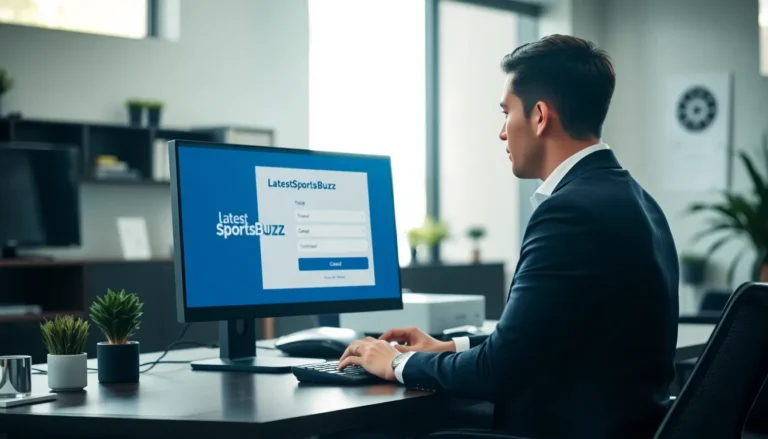Table of Contents
ToggleIn a world where convenience reigns supreme, B2C SaaS is the superhero we never knew we needed. With a click of a button, consumers dive into a sea of subscription services that promise to simplify their lives—like a magic wand, but with fewer rabbits and more software. As businesses scramble to keep up, understanding the latest trends in this dynamic landscape isn’t just smart; it’s essential.
Overview of B2C SaaS Trends
B2C SaaS continues to transform consumer interactions with technology. Increased subscription models dominate, allowing users to access software on a pay-as-you-go basis. Enhanced personalization features play a crucial role, tailoring experiences based on user preferences and behaviors.
Mobile access remains vital, as consumers increasingly rely on smartphones for daily tasks. Real-time data analytics enables businesses to adapt quickly, ensuring optimal user satisfaction. Cloud-based solutions streamline operations, providing seamless updates and ensuring high availability.
Security remains a top priority. Consumers demand robust protection for their personal information as threats evolve. Companies enhancing encryption methods build trust by safeguarding user data during transactions.
Integration with emerging technologies enhances product offerings. Artificial intelligence and machine learning capabilities drive better decision-making by predicting user needs. Additionally, chatbots improve customer support, offering instant assistance at any time.
Social media integration fosters community engagement. Brands leveraging platforms to connect with customers create a vibrant online presence. User-generated content, such as reviews and feedback, influences buying decisions and strengthens brand loyalty.
Subscription fatigue emerges as a challenge. Many consumers grow overwhelmed by the sheer number of services available. Businesses addressing this issue by simplifying purchasing decisions will likely retain user interest.
Staying attuned to these trends provides a competitive edge. Adapting to shifting consumer preferences ensures businesses remain relevant in a growing landscape.
Emerging Technologies in B2C SaaS

Emerging technologies play a crucial role in enhancing B2C SaaS offerings. Businesses increasingly adopt innovative solutions to meet consumer demands and streamline operations.
AI and Machine Learning Integration
Artificial intelligence and machine learning drive efficiency in B2C SaaS applications. These technologies enable personalized experiences by analyzing user data to predict preferences. Companies integrate chatbots to provide instant customer support, reducing response times significantly. Predictive analytics assist brands in understanding customer behavior, leading to more effective marketing strategies. Leveraging these tools boosts customer satisfaction and strengthens brand loyalty. As the competition intensifies, utilizing AI and machine learning becomes essential for maintaining relevance.
Cloud Computing Advancements
Cloud computing advancements enhance the accessibility and scalability of B2C SaaS solutions. Solutions now offer users seamless access from various devices, catering to the mobile-centric consumer base. Updates can occur without disruption, ensuring that users always have the latest features. Companies benefit from reduced infrastructure costs through cloud technology, allowing for quicker deployments. According to industry reports, 90% of businesses experiencing high growth invest in cloud capabilities to improve overall performance. Adopting cloud advancements is vital for success in the fast-paced SaaS landscape.
Consumer Behavior Shifts
Consumer behavior is evolving in the realm of B2C SaaS. To capitalize on this shift, businesses must understand the drivers behind these changes.
Preference for Subscription Models
Consumers increasingly favor subscription models for access to software. Such models provide flexibility and meet the demand for affordable payment options. Users value the ability to pay monthly or annually, allowing for budget-friendly choices. According to recent studies, 70% of consumers prefer subscriptions over one-time purchases. This preference fosters a steady revenue stream for businesses while encouraging user loyalty. Enterprises that embrace subscription-based formats are more likely to adapt to changing consumer expectations.
Importance of User Experience
User experience plays a crucial role in B2C SaaS success. Companies prioritizing intuitive interfaces attract and retain users more effectively. Surveys show that 88% of online consumers are less likely to return to a site after a bad experience. Personalized experiences, driven by user data, significantly enhance satisfaction. Businesses focusing on seamless navigation reduce friction and enhance engagement. High-quality customer support also contributes to an overall positive experience, making it essential for SaaS applications. Investing in user experience ultimately leads to elevated customer retention rates and boosts overall brand loyalty.
Key Players in the B2C SaaS Market
The B2C SaaS market features diverse players contributing to its dynamic landscape. Startups and established companies both play vital roles in shaping this industry.
Startups Disrupting the Market
Startups frequently challenge traditional models by introducing innovative solutions. Companies like Notion and Figma exemplify how fresh ideas can redefine user experiences. They leverage advanced technologies, enhancing personalization and design. Flexibility in pricing attracts consumers eager for affordable options, which drives growth. According to recent data, 70% of consumers prefer subscription models over one-time purchases. This trend empowers startups to capture market share by creating tailored experiences that resonate with users.
Established Companies Adapting
Established companies actively adapt to stay relevant in the evolving B2C SaaS landscape. Adobe and Microsoft invest in integrating emerging technologies to enrich their offerings. These companies expand their subscription services, aligning with consumer preferences for affordability and flexibility. User experience guidance remains crucial, prompting adjustments in interface design and functionality. High-quality customer support contributes significantly to retention, illustrating the need for responsiveness in service. Adapting to trends and emerging technologies has become essential for these companies to maintain competitive advantages.
Future Predictions for B2C SaaS Trends
Predictions for B2C SaaS trends emphasize the continuing shift toward subscription services. By 2025, it’s expected that 80% of consumers will prefer subscription models due to their flexibility and affordability. Enhanced personalization will likely become even more critical, as businesses strive to offer unique experiences tailored to individual user preferences.
Data analytics tools will grow increasingly important in understanding consumer behavior. Real-time insights will allow companies to adjust offerings swiftly, solidifying user satisfaction. Future advancements in artificial intelligence will also play a significant role in B2C SaaS applications. Through sophisticated chatbots, businesses will enhance customer support and drive user engagement.
Mobile access will consistently rise in importance, given the prevalence of smartphone usage. By 2023, approximately 60% of all online transactions will occur on mobile devices. Security measures will need to evolve, addressing consumer concerns by implementing stronger encryption and data protection strategies.
Social media integration will offer new avenues for community engagement, influencing purchasing decisions through authentic user-generated content. Users will demand consistent and seamless experiences across all platforms.
Emerging technologies, particularly improvements in cloud computing, will expand accessibility for B2C SaaS solutions. Businesses will leverage these developments to streamline operations and reduce infrastructure costs. With the number of available services overwhelming some consumers, companies that simplify purchasing decisions will stand out in the competitive landscape.
Investment in user experience continues to be a focal point, especially in attracting and retaining users. High-quality customer support will remain essential, as dissatisfaction can lead to significant churn rates. Thus, B2C SaaS companies must prioritize usability and effective support to foster loyalty and sustain growth in this dynamic environment.
The B2C SaaS landscape is evolving rapidly as businesses adapt to changing consumer preferences. Embracing subscription models and prioritizing user experience are essential for success. Companies that leverage emerging technologies like AI and data analytics will gain a competitive edge by personalizing offerings and enhancing customer support.
As the market continues to grow, security will remain a top concern for consumers. Businesses that prioritize data protection will foster trust and loyalty. Simplifying purchasing processes will help combat subscription fatigue and keep users engaged.
Staying ahead of these trends is crucial for companies aiming to thrive in the B2C SaaS sector. By focusing on innovation and customer satisfaction, businesses can navigate this dynamic environment and secure their place in the future of software services.




